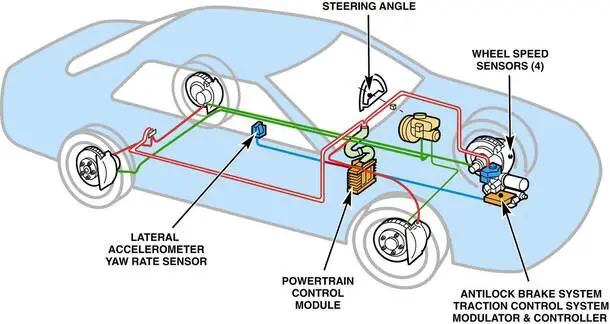A standard passenger car typically has eight brake pads—four for the front axle and four for the rear axle, with two pads per wheel. However, variations exist based on the vehicle type and braking system, such as cars with drum brakes or high-performance vehicles that may have additional pads.
Brakes are one of the most critical components of a vehicle’s safety system, and understanding how many brake pads your car has is essential for maintenance and repair. While most drivers know that brake pads need to be replaced periodically, many are unaware of the specific configuration of brake pads in their vehicles.
This blog post delves into the intricacies of brake pad types, how many brake pads cars typically have, and the importance of regular brake maintenance.

Contents
How Many Brake Pads Does a Car Have?
The number of brake pads in a car generally depends on its braking system and configuration. Here’s a breakdown of how many brake pads are typically found in different types of vehicles:
Basic Configuration
Most passenger vehicles come equipped with four brake pads per axle, meaning that:
- Front Axle: Typically has two brake pads for each wheel, totaling four pads.
- Rear Axle: Generally, has two brake pads for each wheel, also totaling four pads.
Thus, a standard car usually has a total of eight brake pads: four for the front and four for the rear.
Variations in Brake Pad Configurations
While most standard passenger vehicles follow this configuration, there are variations based on different vehicle types and braking systems:
- Vehicles with Disc Brakes: Most modern cars use disc brakes on the front axle and often on the rear as well. Each wheel typically has two pads.
- Vehicles with Drum Brakes: Some older or economy cars may have drum brakes on the rear axle, which use brake shoes instead of pads. Drum brake systems usually have two shoes per wheel.
- High-Performance and Sports Cars: These vehicles might have larger brake systems that can include additional pads or unique configurations for improved performance.
- Electric and Hybrid Vehicles: These cars often incorporate regenerative braking systems that can alter the braking dynamics and may have unique pad configurations compared to traditional vehicles.

Summary of Brake Pad Count by Vehicle Type
Here’s a concise overview of the typical brake pad count based on different vehicle types and braking systems:
| Vehicle Type | Front Brake Pads | Rear Brake Pads | Total Brake Pads |
|---|---|---|---|
| Standard Passenger Vehicle | 4 | 4 | 8 |
| Truck/SUV (Disc Brakes) | 4 | 4 | 8 |
| Sports Car | 4 | 4 or more | 8 or more |
| Vehicle with Drum Brakes | 0 | 4 (2 per wheel) | 4 |
| Electric/Hybrid Vehicle | 4 (or more) | 4 (or more) | 8 (or more) |
Why Brake Pad Count Matters
Understanding the number of brake pads in a vehicle is crucial for several reasons related to safety, performance, maintenance, and cost. Here’s a deeper look into why brake pad count matters:
Maintenance and Replacement
Understanding how many brake pads your car has is essential for:
- Proper Maintenance: Regular inspections can identify worn brake pads before they lead to more severe issues like rotor damage.
- Cost-Effective Repairs: Knowing the count allows for accurate budgeting and preparation when it’s time for a brake pad replacement.
Safety Considerations
Brakes are crucial for safe driving, and knowing the condition and count of your brake pads can help prevent accidents. Worn or damaged brake pads can lead to reduced braking efficiency, increasing stopping distances and risking driver and passenger safety.
Performance Implications
Brake pads are designed for specific performance characteristics. For example, high-performance vehicles often have specialized pads that can withstand higher temperatures, whereas regular passenger vehicles prioritize comfort and quiet operation. Understanding the car’s brake pad configuration can help in selecting the right replacement parts to maintain optimal performance.
Frequently Asked Questions
Here are some FAQs about number of car brake pads –
1. How can I tell if my brake pads need replacing?
Look for signs like squeaking or grinding noises, reduced braking performance, vibration in the brake pedal, and warning lights on your dashboard. Regular visual inspections can also help identify wear.
2. Can I replace just one brake pad?
It’s generally recommended to replace brake pads in pairs (front or rear) to maintain balanced braking performance. Replacing only one pad can lead to uneven wear and compromised braking efficiency.
3. How often should I inspect my brake pads?
Inspect your brake pads at least every 6,000 to 10,000 miles or during regular maintenance checks. If you notice any warning signs, inspect them immediately.
4. Are all brake pads the same?
No, brake pads come in various types (organic, semi-metallic, ceramic) and sizes, designed for different vehicle types and driving conditions. Always choose the correct type for your vehicle.
5. How long do brake pads typically last?
Brake pads usually last between 30,000 to 70,000 miles, depending on driving habits, vehicle type, and brake pad material. Regular inspections can help ensure they are replaced at the right time.
Conclusion
Knowing how many brake pads a car has is essential for any vehicle owner. With a typical passenger vehicle featuring eight brake pads, it’s crucial to monitor their condition regularly and address any signs of wear promptly. By maintaining your brake system and knowing how many brake pads your vehicle has, you can enhance safety, prolong the life of your brakes, and ensure optimal performance on the road.